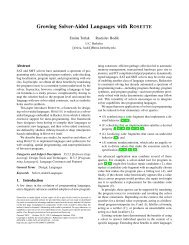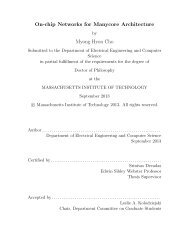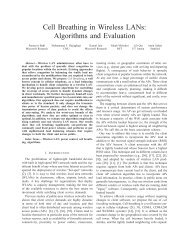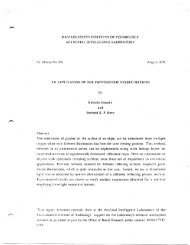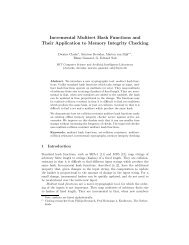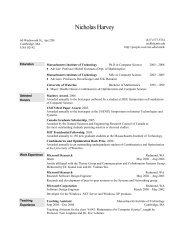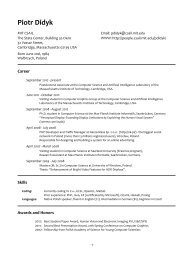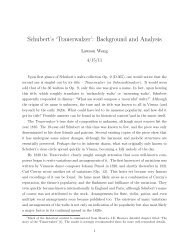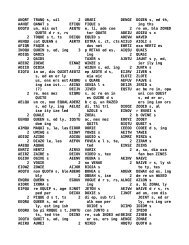Solution Key- 7.012 Problem Set 6 - CSAIL People
Solution Key- 7.012 Problem Set 6 - CSAIL People
Solution Key- 7.012 Problem Set 6 - CSAIL People
Create successful ePaper yourself
Turn your PDF publications into a flip-book with our unique Google optimized e-Paper software.
<strong>Solution</strong> <strong>Key</strong>- <strong>7.012</strong> <strong>Problem</strong> <strong>Set</strong> 6<br />
Question 1<br />
Following is the schematic of a signal transduction pathway that is activated by the binding of<br />
Epidermal growth factor (EGF), produced by one cell type, to its specific membrane receptor on a<br />
target cell. The major steps involved in this pathway are outlined below:<br />
• EGF ligand binds to the EGF receptor.<br />
• Ligand bound EGF receptors become active through phosphorylation and homodimerization.<br />
• Active EGF receptor causes Ras to exchange its bound GDP for GTP and become active.<br />
• Active Ras activates the kinase cascade (RAF, MEK and MAPK) through phosphorylation.<br />
• This increases the expression of c-myc gene which results in cell proliferation.<br />
EGF Receptor<br />
MAPK<br />
MAP<br />
K<br />
Cytosol<br />
P<br />
c-myc transcription<br />
Cell proliferation<br />
Plasma membrane<br />
a) What would be the effect of each of the following treatments/mutations on cell proliferation?<br />
Explain why you see this effect.<br />
i. A mutation that results in the constitutive homodimerization of EGF receptor.<br />
The homodimerization of EGF receptor is required for the activation of Ras-Raf –MEK-MAPK kinase cascade that<br />
increases c-myc gene expression. Therefore a mutation that results in constitutive dimerization of the EGF<br />
receptor will result in constitutive / uncontrolled cell proliferation irrespective of the presence or absence of EGF.<br />
ii. Treatment of cells with a Raf specific phosphatase.<br />
This treatment will inactivate the Raf kinase enzyme. As a result there will be no phosphorylation and activation<br />
of MEK and MAPK. Hence there will be no c-myc gene expression and no cell proliferation even in the presence<br />
of EGF.<br />
iii. Treatment of cells with PD9809, an inhibitor of MAPK.<br />
This treatment will inactivate the MAPK enzyme. As a result there will be no phosphorylation and activation of<br />
MAPK, no c-myc gene expression and no cell proliferation even in the presence of EGF.<br />
EGF<br />
RAS-GTP<br />
Nucleus MAPK<br />
RAF<br />
MEK<br />
b) Consider the following cells that have mutations in different components of the EGF signal<br />
transduction pathway.<br />
• Mutant 1 (m1): Ras protein that continues to stay in its GDP bound form.<br />
• Mutant 2 (m2): RAF protein that lacks its kinase domain.<br />
• Mutant 3 (m3): MAPK that lacks a nuclear localization sequence.<br />
• Mutant 4 (m4): EGF receptor that lacks its extracellular domain.<br />
• Mutant 5 (m5): MAPK that is constitutively phosphorylated at its active site.<br />
• Mutant 6 (m6): c-myc gene that has a constitutively active promoter.<br />
P<br />
P<br />
P<br />
1
Question 1 continued<br />
Complete the table for each of the following homozygous double mutants in the presence of EGF<br />
relative to wild type (wt). Also explain the change in cell proliferation relative to wt cells in the<br />
presence of EGF.<br />
Mutations in<br />
the cell<br />
wt/wt Yes<br />
m1/m1 and<br />
m2/m2<br />
m3/m3 and<br />
m6/m6<br />
m4/m4 and<br />
m5/m5<br />
c-myc<br />
expressed<br />
(Yes/No?)<br />
Cell proliferation increased/decreased /unchanged? Explain.<br />
No Decreased proliferation. Both Ras and Raf kinases are constitutively inactive and so<br />
the cascade is never turned on to enhance c-myc gene expression that is required for<br />
cell proliferation.<br />
Yes Increased proliferation. Since c- myc gene has a constitutively active promoter it will<br />
always be transcribed independent of the active/inactive state of MAPK, which results<br />
in increased cell proliferation.<br />
Yes Increased proliferation. MAPK is constitutively active in its phosphorylated form,<br />
which causes increased c-myc expression that is required for cell proliferation.<br />
c) Ligand mediated signaling events can be classified as endocrine, autocrine or paracrine. Of what is<br />
EGF signaling pathway an example? Explain your choice.<br />
The EGF ligand is secreted by one cell type and it mediates its effect by binding to the EGF receptors on another<br />
cell. This is an example of paracrine signaling.<br />
Question 2<br />
You decide to engineer mammalian cell lines, each expressing a specific mutant variant of either the<br />
EGF ligand or the EGF receptor (EGFR). Note: A cell line is a single type of cell which continuously grows in<br />
culture.<br />
Cell line-1 has a mutation that results in the deletion of only the signal sequence of EGF ligand.<br />
Cell line-2 has a mutation that results in the deletion of only the transmembrane domain of EGFR.<br />
Cell line-3 has a mutation that results in the deletion of both the signal sequence and transmembrane<br />
domain of EGFR.<br />
You incubate each of these mutant cell lines with fluorescent antibodies that specifically bind either to<br />
EGF or the EGFR. You then observe these cell lines under the fluorescent microscope to study the<br />
localization of EGF ligand or EGFR.<br />
a) In cell line-1…….<br />
i. Where do you expect to find the EGF ligand (cell membrane/cytosol/ cell culture medium/)? Explain<br />
your choice.<br />
A protein is secreted if and only if it has a signal sequence. In comparison a protein, in order to get localized to the<br />
cell membrane, has to have a signal sequence and a hydrophobic /transmembrane domain sequence. Since the<br />
signal sequence is deleted, the EGF ligand will be localized in the cytosol.<br />
ii. For the EGF ligand…<br />
• In the template DNA strand, where do you expect to see the base sequence that<br />
corresponds to signal sequence of EGF (close to the 5’ end or the 3’ end)?<br />
You would expect the signal sequence to be located near the 3’ end of the template DNA strand.<br />
• In the mRNA transcript of EGF, where do you expect to see the base sequence that<br />
corresponds to signal sequence of EGF (close to the 5’ end or the 3’ end)?<br />
Once transcribed the signal sequence will be on the 5' end of the mRNA.<br />
• In the EGF ligand, where do you expect to see the signal sequence (close to the N- or C-<br />
terminus)?<br />
During translation the signal sequence will be at the N-terminus of the translated protein.<br />
2
Question 2 continued<br />
b) If cell line-2 is incubated with EGF ligand, do you expect these cells to proliferate? Answer as Yes/No<br />
and explain your choice.<br />
The EGF receptor variant in this cell line has the signal sequence but lacks the hydrophobic / transmembrane<br />
domain sequence. Therefore this protein variant will be secreted by the cell in the surrounding medium. Thus the<br />
EGF receptor will not be available at the cell membrane to bind to EGF ligand and activate Ras-Raf–MEK-<br />
MAPK kinase pathway that is required for cell proliferation.<br />
d) If cell line-3 is incubated with EGF ligand, do you expect these cells to proliferate? Answer as<br />
Yes/No and explain your choice.<br />
The EGF receptor variant in this cell line lacks both the signal sequence and the hydrophobic / transmembrane<br />
domain sequence. Therefore this protein variant will remain localized in the cytosol. Thus the EGF receptor will<br />
not be available at the cell membrane to bind to EGF ligand. Therefore the Ras-Raf –MEK-MAPK kinase pathway<br />
will not be stimulated, there will be no transcription of c-myc gene and hence there will be no cell proliferation.<br />
Question 3<br />
a) What is membrane potential? Is membrane potential exclusively present in neurons?<br />
All cells have an unequal distribution of charges across their plasma membrane and this results in the outside<br />
being more positive compared to the inside. This unequal distribution of charges across the plasma membrane is<br />
called membrane potential. This is a property of all cells and not exclusively the neurons.<br />
b) How does a membrane potential relate to an action potential?<br />
The resting membrane potential is an electrochemical potential of all cells, and can be exploited to do some forms<br />
of cellular work. The action potential is the response within a neuron that can also be relayed to other cells. It is a<br />
transient change of the membrane potential in a tiny patch of the membrane. This transient change is propagated<br />
down the length of the neuronal axon and can result in signals from one neuron to another.<br />
c) Shown below is a plot of axonal membrane potential as a function of time, measured at a single<br />
position on the axon.<br />
C<br />
+50mV<br />
-70mV<br />
A<br />
B<br />
Time<br />
3
Question 3 continued<br />
Complete the following table for each of the three time points indicated in the graph on page 3. Name<br />
the phase of membrane potential that describes the time point, the channels/pumps that are involved<br />
(Select from Na+/K+ ATPase pump, open K+ channels, voltage gated Na+ channels, voltage gated K+ channels,<br />
voltage gated Ca+ channels, ligand gated channels) and explain how these channels/pumps maintain that<br />
phase.<br />
Time<br />
point<br />
A Resting<br />
Phase All the ion channel/<br />
Pump involved<br />
Na+/K+ pump<br />
& open K+ channels<br />
B Depolarization Voltage gated Na+<br />
Channels<br />
C Repolarization Voltage gated<br />
K+Channels<br />
Explanation<br />
Na+/K+ pump creates a difference in concentration for both<br />
Na+ and K+ across the cell membrane. The relative<br />
concentration of Na+ is high outside as compared to inside<br />
and the relative concentration of K+ is low outside as<br />
compared to inside the cell. The open K+ channel always<br />
allows K+ to flow out of the cell. As K+ moves out of the cell,<br />
down its concentration and electrical gradients, the inside of<br />
the cell becomes negative with respect to the outside of the cell.<br />
K+ moves out of the cell until the driving force of the<br />
concentration gradient equals the driving force of the<br />
electrical gradient, which for most cells sets the resting<br />
membrane potential at -70 mV.<br />
These channels, once activated, allow the Na+ ions to move<br />
into the cells down its concentration and electrical gradient<br />
making the inside more positive relative to outside thus<br />
depolarizing the membrane.<br />
These channels, once activated, allow the K+ ions to move out<br />
of the cells making the inside more negative relative to outside<br />
thus repolarizing the membrane.<br />
d) The following schematic shows the tracings of action potentials recorded in the same type of<br />
neurons isolated from several mouse mutants. Each mutant has a defect in only one of the channels or<br />
pumps involved in action potential. You stimulate each neuron, record the electrical activity and plot<br />
your data below. Using the data below, state the channel /pump that most likely has the defect in each<br />
of the mutants and explain how this defect may account for the observed changes in the action<br />
potential compared to the wild type neuron.<br />
Wild type Mutant A<br />
mV mV<br />
770m<br />
V70<br />
mV<br />
Time<br />
Mutant B<br />
770m<br />
V70<br />
mV<br />
mV mV<br />
Time<br />
Time 770m<br />
V70<br />
mV<br />
Time<br />
Mutant C<br />
4
Question 3 continued<br />
Mutants Which channel or pump is<br />
most likely defective?<br />
A Voltage gated K+ channel or voltage<br />
gated Na+ channel.<br />
B Na+K+ ATPase Pump or open K+<br />
channel<br />
C Voltage gated Na+ channel<br />
How does this defect account for the observed<br />
change in the action potential?<br />
The cell is slow to repolarize, suggesting that either the<br />
Voltage-gated K+ is slow to open or fails to open or the<br />
Voltage-gated Na+ is slow to close.<br />
Na+/K+ pump and / or K+ pump are less active than usual.<br />
No action potential is initiated even though threshold is<br />
reached. Voltage-gated Na+ channel fails to open.<br />
e) A student shows you some new data, obtained from a newly isolated neuronal cell line and claims<br />
that the amplitude of action potential varies with the amount of stimulation (1X, 5X and 25X). You are<br />
quite skeptical about these data and think the student has made a mistake. Explain.<br />
The student has made a mistake because the frequency of the action potential can increase with the stimulus but<br />
the amplitude remains unchanged.<br />
f) Indicate, on the graph below, how a normal neuron would react if the strength of stimulus is<br />
increased from 1X to 5X or 25X.<br />
mV mV mV<br />
mV<br />
Time Time Time<br />
Stimulus IX 5X 25X<br />
Question 4<br />
Cystic fibrosis (CF), is an autosomal recessive disorder. This is caused by a defect in a gene called the<br />
cystic fibrosis transmembrane conductance regulator (CFTR) gene located on chromosome 7 that makes<br />
the CFTR protein. This protein functions as a chloride channel across the cell membrane, controls the<br />
movement of water in tissues and maintains the fluidity of mucus and other secretions.<br />
a) Below are three different options for a hypothetical linear stretch of amino acids present in the CFTR<br />
protein channel.<br />
Option 1: ……… - arg-cys-ala-his-trp-val-glu-lys-arg ……….<br />
Option 2: ……… -leu-ala-gly-cys-phe-val-gly-trp-met……….<br />
Option 3: ……… -leu-ser-gly-lys-phe-val-gly-tyr-met ………..<br />
i. Which option most likely forms a stretch of CFTR receptor that spans/comes in contact with the<br />
lipid bilayer? Explain why you selected this option.<br />
Option #2 since this option contains a continuous stretch of non-polar/ hydrophobic amino acids.<br />
ii. The CFTR protein has a regulatory binding site that allows its activation by phosphorylation.<br />
Which of the above options can most likely be phosphorylated.<br />
Only serine, tyrosine and threonine amino acids have -OH groups in their sidechains and can therefore be<br />
phosphorylated. Since ser and tyr are present only in option #3 therefore this is the most likely option for<br />
phosphorylation.<br />
5
Question 4 continued<br />
b) CF trait is most common in people with European heritage that show the deletion of a codon<br />
corresponding to phenylalanine amino acid at 508 th position in the CFTR protein. In general, the alleles<br />
that correspond to an autosomal recessive trait may exist at a fairly high frequency in some regions of<br />
the world. Provide two reasons to explain why the CF trait is so common in some regions.<br />
It may so be that the allele responsible for the occurrence of this disease somehow provides resistance to some other<br />
infection, which is otherwise fairly common in these regions. Hence many individuals in these regions are the<br />
carriers for the disease but are phenotypically normal and yet have resistance to some other infection that is fairly<br />
common in that region. This may also be owing to the bottle neck and founder effect where most people in the<br />
region have a common ancestry.<br />
c) Blood test is one of the diagnostic methods for CF. You have the blood samples from 5 newborns and<br />
you want to PCR amplify and sequence the CFTR genes from these samples to look for mutations.<br />
Based on what information would you design a primer pair that you could use to PCR amplify and<br />
sequence the CFTR gene from these newborns?<br />
The sequence of the wild type CFTR gene is known. You will use this information to design the primers to PCR<br />
amplify and test the CFTR genes in these newborns. Or you can use the flanking regions of the CFTR gene to<br />
design your primer pair.<br />
You also analyze the A locus that is close to the CFTR gene. The only difference between the wild type<br />
allele (A) and the allele associated with the CF ( A’) is that A’ allele lacks an internal EcoR1 restriction<br />
site which is present in the A allele.<br />
EcoR1<br />
A allele<br />
A’allele<br />
The A locus from the DNA of five newborns is amplified using PCR. The PCR products are digested<br />
with EcoR1 and the resulting fragments are separated by agarose gel electrophoresis as shown below.<br />
1 2 3 4 5 Normal<br />
b) Based on the PCR analysis of the A locus, identify the newborns as normal/ having CF / having CF<br />
trait and write the genotypes at the A locus for individuals #1 through #5.<br />
Samples Genotype at the A locus Normal/CF trait/ CF disease<br />
1 A’A’ CF disease<br />
2 AA Normal<br />
3 AA Normal<br />
4 AA’ CF trait<br />
5 AA’ CF trait<br />
Control AA<br />
(-)<br />
A’<br />
A<br />
(+)<br />
6
Question 4 continued<br />
e) Individuals with CF often experience respiratory illness for which they are prescribed a wide<br />
spectrum of antibiotics. Even after being treated with antibiotics these patients may ultimately require<br />
lung transplant. Explain why.<br />
Excessive and continuous treatment with antibiotics creates an environment for the bacterial cells to develop<br />
resistance against antibiotics. This may ultimately lead to a point where lung transplant remains the only option<br />
for the affected individual.<br />
f) In 1985, the specific gene that causes cystic fibrosis was identified. Recently, laboratory tests of gene<br />
therapy have been successful. Explain how gene therapy may be useful in treating these patients.<br />
Gene therapy is the insertion of genes into an individual's cells and tissues to treat a disease such as CF in<br />
which a deleterious mutant CFTR allele is replaced with a functional one. Gene therapy may be classified into the<br />
following types. Germ line gene therapy; In the case of germ line gene therapy, germ cells, i.e., sperm or eggs,<br />
are modified by the introduction of functional genes, which are ordinarily integrated into their genomes.<br />
Therefore, the change due to therapy would be heritable and would be passed on to later generations. This new<br />
approach, theoretically, should be highly effective in counteracting genetic disorders and hereditary diseases.<br />
However, many jurisdictions prohibit this for application in human beings, at least for the present, for a variety of<br />
technical and ethical reasons. Somatic gene therapy; In the case of somatic gene therapy, the therapeutic genes<br />
are transferred into the somatic cells of a patient. Even if 10-15% of cells receive the wild type copy of the gene,<br />
the amount of protein made may be sufficient enough for the affected individual to lead a normal life. With such a<br />
therapy any modifications and their corresponding effects will be restricted to the individual patient only, and<br />
will not be inherited by the patient's offspring.<br />
7



